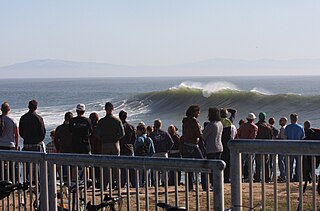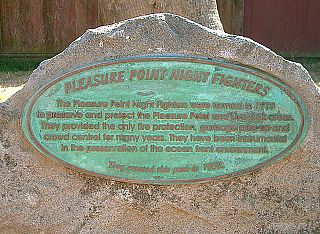
Santa Cruz is the largest city and the county seat of Santa Cruz County, in Northern California. As of the 2020 census, the city population was 62,956. Situated on the northern edge of Monterey Bay, Santa Cruz is a popular tourist destination, owing to its beaches, surf culture, and historic landmarks.

Santa Cruz County, officially the County of Santa Cruz, is a county on the Pacific coast of the U.S. state of California. As of the 2020 census, the population was 270,861. The county seat is Santa Cruz. Santa Cruz County comprises the Santa Cruz–Watsonville, CA Metropolitan Statistical Area, which is also included in the San Jose–San Francisco–Oakland, CA Combined Statistical Area. The county is on the California Central Coast, south of the San Francisco Bay Area region. The county forms the northern coast of the Monterey Bay, with Monterey County forming the southern coast.

Monterey Bay is a bay of the Pacific Ocean located on the coast of the U.S. state of California, south of the San Francisco Bay Area. San Francisco itself is further north along the coast, by about 75 miles, accessible via CA 1 and US 101.

Capitola is a small seaside town in Santa Cruz County, California. Capitola is located on the northern shores of Monterey Bay, on the Central Coast of California. The city had a population of 9,938 at the 2020 census. Capitola is a popular tourist destination, owing to its beaches and restaurants.

The Central Coast is an area of California, roughly spanning the coastal region between Point Mugu and Monterey Bay. It lies northwest of Los Angeles and south of the San Francisco Bay Area, and includes the rugged, rural, and sparsely populated stretch of coastline known as Big Sur.

Bernard Ralph Maybeck was an American architect in the Arts and Crafts Movement of the early 20th century. He was an instructor at University of California, Berkeley. Most of his major buildings were in the San Francisco Bay Area.

Cabrillo College is a public community college in Aptos, California. It is named after the conquistador Juan Rodríguez Cabrillo and opened in 1959. Cabrillo College has an enrollment of about 9,700 students per term.

New Brighton State Beach is a 95 acres (38 ha) beach park on Monterey Bay in Santa Cruz County, California, consisting of a beach and campgrounds. The park is located east of Santa Cruz in Capitola, on Park Avenue off of Highway 1. The park is adjacent to Seacliff State Beach, which is known for its fishing pier and sunk concrete freighter, The Palo Alto. The beach overlooks Soquel Cove and Monterey Bay.

American Craftsman is an American domestic architectural style, inspired by the Arts and Crafts movement, which included interior design, landscape design, applied arts, and decorative arts, beginning in the last years of the 19th century. Its immediate ancestors in American architecture are the Shingle style, which began the move away from Victorian ornamentation toward simpler forms, and the Prairie style of Frank Lloyd Wright.

The Awaswas, also known as the Santa Cruz people, were a group of the Indigenous peoples of California in North America, with subgroups historically numbering about 600 to 1,400. Academic research suggests that their ancestors had lived within the Santa Cruz Mountains region for approximately 12,000 years. The Awaswas maintained regular trade networks with regional cultures before the Spanish colonists began settling in the area from the 18th century.

The Pleasure Point Roadhouse was a historic building on the Monterey Bay, located at 2-3905 East Cliff Dr., 95062 in Santa Cruz County, California. It was torn down on September 27, 2008.

Steamer Lane is a famous surfing location in Santa Cruz, California. It is just off a point on the side of cliffs in the West Cliff residential area near downtown Santa Cruz, providing easy access and a good vantage point for viewing. The Santa Cruz Surfing Museum is housed in a lighthouse there. "Steamer Lane" is the preferred form of the name used by the people surfing there. Steamer Lane was named by Claude Horan while he was a student at San Jose State in the late 1930s. One flat calm day he and his friend Wes Hammond thought it would be a good idea to hire steamships to cruise back and forth to generate waves for surfing. It was at Steamer Lane that the modern surfing wetsuit and the leash were mainly developed by Jack O'Neill, who had his surf shop nearby for many years.

The Pleasure Point Night Fighters, a.k.a. PPNF, is a community-oriented organization that comes together to preserve and protect the Pleasure Point area and originated Pack Your Trash.

Bill Lee is the designer of noted ocean racing yachts, and one of the founders of the Santa Cruz school of boatbuilding. Known to many as the Wizard, Lee's designs achieved notoriety in the 1970s, with Chutzpah and Merlin having won the Transpacific Yacht Race from Los Angeles to Honolulu many times. Merlin set and held the course record between 1977 and 1997, making the 1977 crossing in only 8 days, 11 hours and 1 minute.

Soquel Canyon State Marine Conservation Area (SMCA) is an offshore marine protected area in Monterey Bay. Monterey Bay is on California’s central coast with the city of Monterey at its south end and the city of Santa Cruz at its north end. The SMCA covers 23.41 square miles (60.6 km2). Within the SMCA, fishing and taking of any living marine resources is prohibited except the commercial and recreational take of pelagic finfish.

Pleasure Point is a census-designated place (CDP) in Santa Cruz County, California. Pleasure Point sits at an elevation of 33 feet (10 m). The 2020 United States census reported Pleasure Point's population was 5,821. Prior to the 2010 census, this CDP was called Opal Cliffs.
Soquel Demonstration State Forest is one of eight Cal Fire-operated Demonstration State Forests totaling 71,000 acres. Collectively, the forests represent the most common forest types in California. The State Forests grow approximately 75 million board feet yearly and harvest an average of 30 million board feet of timber each year, enough to build 3,000 single-family homes. Revenue from these harvests funds a variety of the Department's Resource Management Programs. In addition, the forests provide research and demonstration projects on forest management, while providing public recreation opportunities, fish and wildlife habitat, and watershed protection.

The Santa Cruz Yacht Club (SCYC) is a yacht club founded in 1928 and is the oldest, and currently the only, yacht club in Santa Cruz, California.

Aptos Creek is a southward flowing 9.5 miles (15.3 km) creek that begins on Santa Rosalia Mountain on the southwestern slope of the Santa Cruz Mountains in Santa Cruz County, California and enters Monterey Bay, at Seacliff State Beach in Aptos, California.

The Wilson Building, also known as the Philip Wilson Building is a historic commercial building in downtown Carmel-by-the-Sea, California. It is an example of American Craftsman architectural style that was built in 1905 on the corner of Ocean Avenue and Dolores Street as a real estate office. In 1916 it became Carmel’s first official City Hall. The building qualified as an important building in the city's downtown historic district property survey and was recorded with the California Register of Historical Resources on November 30, 2002. The building is occupied by two tenants, the J. McLaughlin and The Agency.




















